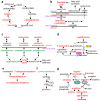Landscape of the mitochondrial Hsp90 metabolome in tumours
- PMID: 23842546
- PMCID: PMC3732457
- DOI: 10.1038/ncomms3139
Landscape of the mitochondrial Hsp90 metabolome in tumours
Erratum in
-
Corrigendum: Landscape of the mitochondrial Hsp90 metabolome in tumours.Nat Commun. 2015 Jun 18;6:7605. doi: 10.1038/ncomms8605. Nat Commun. 2015. PMID: 26085380 Free PMC article. No abstract available.
Abstract
Reprogramming of tumour cell metabolism contributes to disease progression and resistance to therapy, but how this process is regulated on the molecular level is unclear. Here we report that heat shock protein 90-directed protein folding in mitochondria controls central metabolic networks in tumour cells, including the electron transport chain, citric acid cycle, fatty acid oxidation, amino acid synthesis and cellular redox status. Specifically, mitochondrial heat shock protein 90, but not cytosolic heat shock protein 90, binds and stabilizes the electron transport chain Complex II subunit succinate dehydrogenase-B, maintaining cellular respiration under low-nutrient conditions, and contributing to hypoxia-inducible factor-1α-mediated tumorigenesis in patients carrying succinate dehydrogenase-B mutations. Thus, heat shock protein 90-directed proteostasis in mitochondria regulates tumour cell metabolism, and may provide a tractable target for cancer therapy.
Conflict of interest statement
Y.C.C., A.A., A.S.T., R.D.M., D.C.W., L.R.L., D.W.S., and D.C.A. designed research; Y.C.C., A.A., K.D.S., H.W., J.F.P., and E.D.K. performed research; S.L., K.P., S.F. and R.D.M. contributed new reagents/analytical tools; Y.C.C., A.A., A.S.T., R.D.M., D.C.W., L.R.L., D.W.S., and D.C.A. analyzed data, and Y.C.C., A.A., A.S.T., D.C.W., D.W.S., and D.C.A. wrote the paper.
The authors declare no competing financial interest.
Figures





References
-
- Kroemer G, Pouyssegur J. Tumor Cell Metabolism: Cancer’s Achilles’ Heel. Cancer Cell. 2008;13:472–482. - PubMed
-
- Koppenol WH, Bounds PL, Dang CV. Otto Warburg’s contributions to current concepts of cancer metabolism. Nat Rev Cancer. 2011;11:325–337. - PubMed
-
- Matoba S, et al. p53 regulates mitochondrial respiration. Science. 2006;312:1650–1653. - PubMed
Publication types
MeSH terms
Substances
Grants and funding
- R01 CA078810/CA/NCI NIH HHS/United States
- CA78810/CA/NCI NIH HHS/United States
- R37 HL054131/HL/NHLBI NIH HHS/United States
- P30 CA010815/CA/NCI NIH HHS/United States
- CA140043/CA/NCI NIH HHS/United States
- NS021328/NS/NINDS NIH HHS/United States
- CA010815/CA/NCI NIH HHS/United States
- R01 CA118005/CA/NCI NIH HHS/United States
- R01 NS021328/NS/NINDS NIH HHS/United States
- CA118005/CA/NCI NIH HHS/United States
- P01 CA140043/CA/NCI NIH HHS/United States
- HL54131/HL/NHLBI NIH HHS/United States
- R01 HL054131/HL/NHLBI NIH HHS/United States
LinkOut - more resources
Full Text Sources
Other Literature Sources
Medical
Miscellaneous

